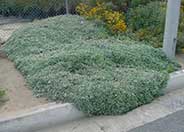
Common name:California Fescue
Botanical name:Festuca californica
The California Fescue is a cool season bunchgrass with blue green blades that reach 2'-5' high and 3' wide. Foliage arches gracefully upwards and outwards. Flower spikes reach 3' above the leaves. Plant in full sun or partial shade. It makes a great companion plant to oak trees and is handsome as a backdrop behind lower growing grasses for a meadow look. The California fescue is native to California and is a beneficial insect plant. -Cornflower Farms

Common name:Silver Carpet Lessingia
Botanical name:Lessingia flilaginifolia 'Silver Carpet'
Silver Carpet Lessingia is one of the best native groundcovers for use in large areas. It grows very quickly once established in the ground and requires little to no care. It will tolerate almost regular water to very little. The fuzzy silver foliage remains attractive through most of the year. Small pink to lavender flowers appear on the foliage intermittently throughout the year for added interest. This plant is very vigorous and should not be planted in small areas. It will grow to 6'-8' tall.

Common name:California Sycamore
Botanical name:Platanus racemosa
The California Sycamore is a fast growing deciduous tree that reaches up to 40'-50' high. It tolerates heat, smog, and drought conditions as well as moist conditions; it is native to riparian areas. It has interesting mottled bark when the tree is bare in winter.

Common name:Yellow Stalked Bulbine
Botanical name:Bulbine frutescens
Bulbine frutescens is an evergreen perennial that grows 1' in height and 1'-3' in spread. The leaves are narrow and long. This low- spreading plant is attractive year round.
Pest Management
Are pests bugging you? If pests are taking over there might be a good reason! Instead of grabbing that bottle of spray, consider using techniques that can solve your pest problems without toxic pesticides.
Click in the green box for more information
| Designer: | Maloof 6 |
Photographer: GardenSoft |
Soils and Compost:
Physical weed control, including mulching, or hand removal protects the watershed from harmful chemicals.
Water Saving Tip:
Integrated Pest Management:
Remove irrigation water and fertilizer from areas where you don't want weeds to grow.

